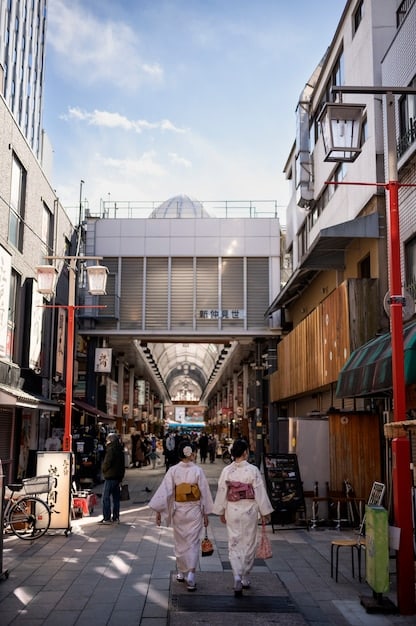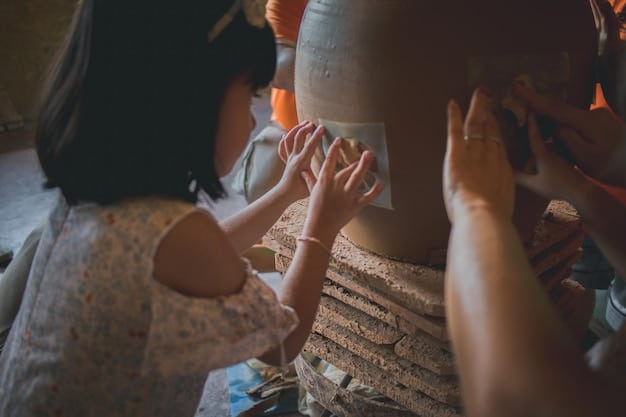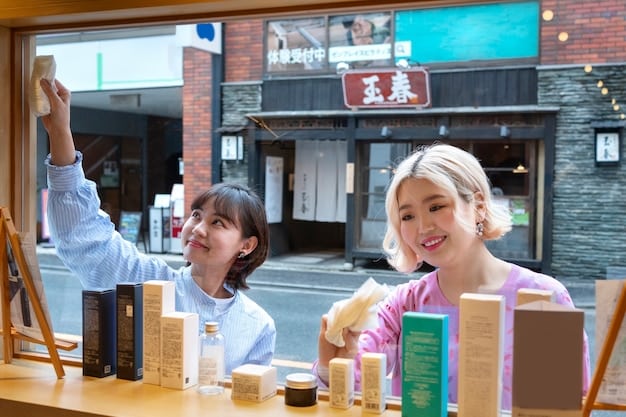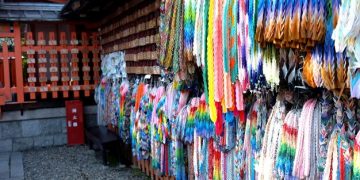Authentic Japanese Shopping: Tips for US Shoppers Avoiding Tourist Traps

Avoiding Tourist Traps: Insider Tips for US Shoppers to Find Authentic Japanese Products at Fair Prices provides a comprehensive guide for US consumers looking to purchase genuine Japanese goods, focusing on strategies to navigate tourist-heavy areas and identify reliable sources for quality items.
For US shoppers eager to bring a piece of Japan home, navigating the bustling markets and souvenir shops can be overwhelming. **Avoiding Tourist Traps: Insider Tips for US Shoppers to Find Authentic Japanese Products at Fair Prices** equips you with the knowledge to find genuine treasures, ensuring your shopping experience is both rewarding and authentic.
Understanding the Allure of Authentic Japanese Products
The allure of authentic Japanese products extends beyond mere souvenirs; it’s about acquiring a tangible piece of Japanese culture, craftsmanship, and history. From intricate ceramics to meticulously crafted textiles, these items embody a dedication to quality and tradition that resonates with collectors and enthusiasts alike.
Unfortunately, the desire for these authentic goods often leads shoppers into tourist traps, where inflated prices and lackluster quality are common. Understanding the characteristics of genuine Japanese products and where to find them is crucial for a satisfying and authentic shopping experience.
The Essence of Japanese Craftsmanship
Japanese craftsmanship, known as “Takumi,” emphasizes precision, attention to detail, and a deep respect for materials. Traditional techniques, passed down through generations, often involve intricate processes and specialized skills. This commitment to excellence results in products that are not only beautiful but also durable and functional.
- Superior Materials: Authentic Japanese products often utilize high-quality, locally sourced materials.
- Handcrafted Elements: Many items incorporate handcrafted elements, showcasing the artisans’ skill and dedication.
- Functional Art: Japanese design often blends functionality with artistic expression, creating items that are both practical and aesthetically pleasing.
Why Avoid Tourist Traps?
Tourist traps, while convenient, frequently offer overpriced and mass-produced items that lack the quality and authenticity of genuine Japanese goods. These establishments often cater to impulse purchases and may not prioritize customer satisfaction or ethical sourcing.
By avoiding these traps and seeking out alternative shopping venues, US shoppers can not only acquire authentic products but also support local artisans and businesses, contributing to the preservation of Japanese craftsmanship.

Ultimately, understanding the allure and value of authentic Japanese products is the first step in ensuring a rewarding and genuine shopping experience. By being informed and selective, US shoppers can bypass tourist traps and acquire treasures that truly reflect the beauty and craftsmanship of Japan.
Researching Before You Shop: Online Resources and Local Insights
In the digital age, thorough research is your best weapon against tourist traps. Before embarking on your Japanese shopping adventure, delve into online resources and seek local insights to identify reputable shops and avoid overpriced tourist spots.
Doing your homework not only saves you money but also enhances your appreciation for the products you’re buying and the culture they represent.
Utilizing Online Resources for Research
Numerous online platforms offer valuable information for US shoppers seeking authentic Japanese products. From reputable e-commerce sites to specialized forums and blogs, the internet provides a wealth of knowledge to guide your purchasing decisions.
- Reputable E-commerce Sites: Look for well-established online retailers specializing in Japanese goods, with transparent sourcing and customer reviews.
- Specialized Forums and Blogs: Engage with online communities dedicated to Japanese crafts and culture to gather insider tips and recommendations.
- Social Media: Follow Japanese artisans, designers, and retailers on social media for inspiration and updates on new products and promotions.
Leveraging Local Insights
Connecting with locals or expats living in Japan can provide invaluable insights into the best shopping destinations and hidden gems. Their personal recommendations and experiences can help you navigate the market and discover authentic products that you might otherwise overlook.
Consider joining online forums or social media groups for expats in Japan, attending local cultural events, or even hiring a local guide to enhance your shopping experience.
Essential Japanese Phrases for Shopping
Learning a few basic Japanese phrases can significantly improve your shopping experience and demonstrate your respect for local culture. Simple greetings, polite requests, and questions about product details can go a long way in building rapport with shopkeepers and ensuring a smoother transaction.
Consider learning phrases such as “Kore wa nan desu ka?” (What is this?), “Ikura desu ka?” (How much is it?), and “Arigato gozaimasu” (Thank you very much) to enhance your interactions and show your appreciation.

In conclusion, diligent research and leveraging local insights are crucial steps in **avoiding tourist traps** and finding authentic Japanese products. By utilizing online resources, connecting with locals, and learning basic Japanese phrases, US shoppers can enhance their shopping experience and acquire genuine treasures that reflect the rich culture of Japan.
Identifying Authentic Japanese Products: Key Characteristics and Red Flags
Distinguishing authentic Japanese products from mass-produced imitations requires a keen eye and an understanding of the key characteristics that define genuine craftsmanship. By learning to identify these traits and recognizing common red flags, US shoppers can confidently navigate the market and avoid purchasing inferior goods.
This section will equip you with the knowledge to discern quality and authenticity, ensuring that your purchases are a true reflection of Japanese craftsmanship.
Hallmarks of Authentic Japanese Craftsmanship
Authentic Japanese products often exhibit hallmarks of quality craftsmanship, including meticulous attention to detail, the use of premium materials, and the incorporation of traditional techniques. These characteristics are a testament to the artisans’ dedication and skill, resulting in products that are both beautiful and durable.
- Attention to Detail: Examine the product closely for fine details, precise stitching, and flawless finishes.
- Premium Materials: Look for high-quality materials, such as locally sourced wood, natural dyes, and handcrafted textiles.
- Traditional Techniques: Inquire about the techniques used in the production process, such as hand-painting, weaving, or pottery firing.
Common Red Flags to Watch Out For
Conversely, certain red flags can indicate that a product is not authentic or of subpar quality. These warning signs often include unusually low prices, generic labeling, and a lack of information about the product’s origin or production process.
Be wary of items that are significantly cheaper than comparable products, bear generic “Made in Japan” labels without specific artisan or brand information, or are sold in locations known for tourist traps.
Understanding Japanese Product Labeling
Familiarizing yourself with Japanese product labeling can also help you identify authentic goods and avoid counterfeit items. Look for labels that include specific information about the product’s materials, origin, and manufacturer, as well as any relevant certifications or quality marks.
Learning to read basic Japanese characters or using a translation app can assist in deciphering product labels and verifying their authenticity.
In conclusion, identifying authentic Japanese products requires a discerning eye and a knowledge of key characteristics and red flags. By examining craftsmanship, scrutinizing labeling, and being wary of suspiciously low prices, US shoppers can confidently select genuine treasures that embody the quality and artistry of Japanese culture.
Navigating Different Shopping Venues: From Department Stores to Local Markets
Japan offers a diverse range of shopping venues, each with its own unique atmosphere and selection of products. From upscale department stores to bustling local markets, understanding the nuances of each venue is essential for US shoppers seeking authentic Japanese goods and **avoiding tourist traps**.
By exploring different shopping environments and tailoring your approach accordingly, you can discover hidden gems and enjoy a more enriching cultural experience.
The Allure of Japanese Department Stores (Depachika)
Japanese department stores, particularly their basement food halls known as “Depachika,” are renowned for their curated selection of high-quality products and impeccable service. These establishments offer a glimpse into Japanese culinary traditions and craftsmanship, with a focus on premium ingredients and artisanal goods.
While prices may be higher than in local markets, Depachika offer a convenient and reliable way to sample a wide range of authentic Japanese products in a sophisticated setting.
Exploring Local Markets and Street Vendors
Local markets and street vendors provide a more authentic and immersive shopping experience, allowing US shoppers to interact directly with artisans and sample regional specialties. These venues often offer unique and handcrafted items that are not available in department stores or tourist shops.
Be prepared to bargain respectfully and use your newfound Japanese phrases to enhance your interactions with vendors.
Visiting Craft Centers and Artisan Workshops
For a truly unique and educational shopping experience, consider visiting craft centers and artisan workshops throughout Japan. These venues allow you to witness the production process firsthand, learn about traditional techniques, and purchase directly from the artisans themselves.
Many workshops offer hands-on experiences, such as pottery making or dyeing, allowing you to create your own personalized souvenirs and gain a deeper appreciation for Japanese craftsmanship.
In conclusion, navigating different shopping venues requires adaptability and an understanding of each venue’s unique characteristics. By exploring department stores, local markets, and craft centers, US shoppers can discover a diverse range of authentic Japanese products and enjoy a more enriching cultural experience.
Bargaining and Payment Customs: Tips for a Smooth Transaction
Understanding bargaining and payment customs is crucial for a smooth and respectful shopping experience in Japan. While aggressive haggling is generally discouraged, there are subtle ways to negotiate prices and ensure you’re getting a fair deal, particularly in local markets and smaller shops.
Learning about these customs and adopting appropriate etiquette will not only save you money but also enhance your interactions with shopkeepers and demonstrate your respect for Japanese culture.
The Art of Polite Negotiation
In Japan, direct and aggressive bargaining is considered impolite. Instead, focus on building rapport with the shopkeeper, expressing genuine interest in their products, and subtly inquiring about potential discounts or special offers.
- Express Appreciation: Begin by admiring the shopkeeper’s products and expressing your genuine interest.
- Inquire Respectfully: Ask politely if there are any discounts available, particularly for multiple purchases.
- Be Prepared to Pay the Asking Price: If the shopkeeper is unwilling to negotiate, be prepared to pay the asking price, as aggressive haggling is considered disrespectful.
Understanding Payment Methods
While credit cards are widely accepted in larger establishments, smaller shops and local markets may prefer cash payments. It’s always a good idea to carry a mix of cash and credit cards to ensure you can make purchases regardless of the vendor’s payment preferences.
Be mindful of currency exchange rates and any associated fees when using credit cards or withdrawing cash from ATMs.
Tax-Free Shopping for Tourists
Many shops in Japan offer tax-free shopping for tourists, allowing you to save on your purchases. To qualify for tax-free shopping, you must present your passport and meet certain minimum purchase requirements. Be sure to inquire about tax-free shopping options when making your purchases.
In conclusion, mastering bargaining and payment customs is essential for a smooth and respectful shopping experience in Japan. By practicing polite negotiation, understanding payment methods, and taking advantage of tax-free shopping options, US shoppers can ensure they’re getting a fair deal while demonstrating their respect for Japanese culture.
Shipping and Customs: Bringing Your Treasures Home
Bringing your newfound treasures home from Japan involves navigating shipping and customs regulations, which can seem daunting for US shoppers. Understanding these processes and planning accordingly will ensure that your purchases arrive safely and without unexpected fees or delays.
This section will provide practical tips and guidance on shipping options, customs declarations, and potential import duties, allowing you to confidently transport your Japanese treasures back to the United States.
Exploring Shipping Options
Several shipping options are available for transporting your purchases from Japan to the United States, each with its own advantages and disadvantages. Consider factors such as cost, speed, and reliability when selecting a shipping method.
- Postal Service (EMS): The Japanese postal service offers a reliable and affordable option for shipping smaller items.
- Courier Services (DHL, FedEx, UPS): Courier services provide faster shipping times and tracking capabilities, but may be more expensive.
- Consolidated Shipping: Consider using a consolidated shipping service if you have multiple items to ship, as they can often offer cost savings.
Navigating Customs Declarations
Accurately completing customs declarations is crucial for avoiding delays and potential penalties. Be sure to declare all of your purchases and provide accurate descriptions and values for each item.
Familiarize yourself with US customs regulations and any restrictions on importing certain items, such as food products or cultural artifacts.
Understanding Import Duties and Taxes
Depending on the value and type of goods you’re importing, you may be required to pay import duties and taxes upon arrival in the United States. Be prepared to pay these fees and factor them into your overall budget.
Consult the US Customs and Border Protection website for information on current duty rates and any applicable exemptions.
In conclusion, shipping and customs regulations require careful planning and attention to detail. By exploring shipping options, accurately completing customs declarations, and understanding import duties and taxes, US shoppers can ensure that their Japanese treasures arrive safely and without unexpected complications.
| Key Point | Brief Description |
|---|---|
| 🔍 Research Online | Use reputable sites and forums for authentic product info. |
| 🧐 Identify Hallmarks | Look for detail, premium materials, traditional craftsmanship. |
| 🤝 Polite Negotiation | Build rapport and subtly inquire about possible discounts. |
| ✈️ Shipping Wisely | Explore all options and navigate customs declarations carefully. |
FAQ Section
▼
Look for the potter’s signature, the quality of the clay, and the painting technique. Authentic pieces often feature unique imperfections that indicate handcrafting. Check for reputable dealers.
▼
Consider local crafts like handcrafted paper items, regional sweets from specialty shops, or locally made textiles like scarves or handkerchiefs. These are more culturally significant.
▼
Flea markets held at temples or shrines often feature artisans selling directly. Local shopping streets away from tourist centers can also offer unique, region-specific, and reasonably priced goods.
▼
Consolidate your purchases and ship via surface mail if time isn’t a concern. Always accurately declare values to avoid customs issues, and check for import duties beforehand.
▼
While many tourist areas cater to English speakers, knowing basic Japanese phrases enhances your experience and helps build rapport with shopkeepers, potentially leading to better deals.
Conclusion
By arming yourself with these insider tips, you’re well-equipped to navigate the Japanese shopping landscape like a seasoned pro. Steer clear of the **tourist traps**, embrace the local markets, and confidently bring home authentic treasures that reflect the true spirit of Japan.





